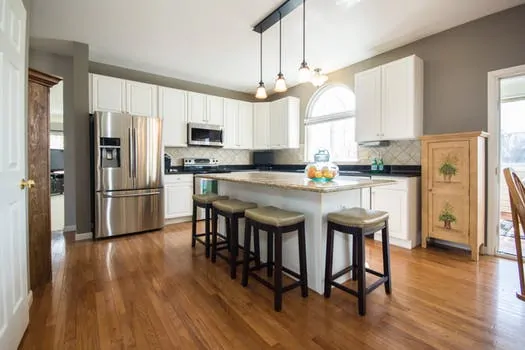
What Is an Open Concept Kitchen
Open concept kitchens seem to be all the rage these days – and with good reason. They maximize the appearance of space, and lend themselves to better functionality and design, especially for a family home. In this article, we will explain exactly what an open concept kitchen is, elements to consider if you’re thinking about installing an open concept kitchen in your home, and how to determine if your house should have an open concept kitchen.
Open Concept Kitchen 101
Open concept spaces in a home are generally defined as the elimination of barriers such as walls and doors that traditionally separated distinct functional areas, such as kitchen, living room, and dining room. In the context of the kitchen, an open concept floor plan is typically based around a kitchen that opens up to a dining room, a dining room and living room (often called a “great room”), or some other combination of multiple rooms.
Open floor plans are visually and aesthetically more “open, ” and often promote a seamless flow of common areas, with multiple rooms being combined into a single living space. These floor plans work extremely well in homes with less square footage, and help busy families with multitasking, since cooking, eating and catching up can all happen more-or-less in the same place.
How Are Open Concept Kitchens Built?
Open concept kitchens are not built or supported the same way as traditional walled kitchens. One of the defining characteristics of an open concept kitchen is that it will not have any walls or partial walls in the common spaces. Instead, the weight of the ceiling or 2nd floor is carried by load-bearing support beams.
History of Open Concept Kitchens
Like open floor plans in general, open concept kitchens are a relatively new development in the world of residential home design.
Traditionally, and up to the mid-1900s, homes were designed and built to accommodate different rooms for different functions. Each room had its own role – the kitchen was for cooking, the dining room was for eating, the living room was for spending time as a family, and so on. To change functions (e.g. to go from cooking to eating), you also had to distinctly change rooms.
Not to mention, kitchens back then were noisy, and potentially dangerous before all the advances that have been made in appliance technology. Stoves could easily overheat, kitchens could become filled with smoke – there were too many possibilities for disaster for the kitchen to be in such a publicly accessible part of the home.
Multi-roomed homes also were somewhat of a status symbol – the number of rooms you had in your house could be associated with what you could afford. Simply put: more rooms traditionally equated higher status.
However, around 1940-1950, things changed. Kitchen design and cooking technology experienced significant improvements, and builders recognized the efficiency using an open layout to combine spaces within a home and better utilize square footage. Although open concept floor plans and kitchens began as an economical, logical option for homeowners, today they have transformed into the preferred option by the majority of homeowners.
In fact, “cellularized” separated rooms reminiscent of closed floor plans are now seen as more “retro” and are making a design resurgence for that reason, even though they were once considered the norm!
Pros & Cons of Open Kitchens
Open concept kitchens are popular, but that doesn’t mean that they don’t have a host of drawbacks (and benefits that should be considered.
For example, while open concept kitchens will certainly promote easier traffic flow between busy rooms, the lack of walls lends itself to a noisier environment. Open concept kitchens can facilitate more social interaction, but can also make it hard to get away if you just need some private time.
Probably one of the biggest benefits of open concepts kitchens is that they almost always add significant value to your home. Especially if you are investing in your home for resale value, an open concept kitchen is an excellent choice.
For more detailed pros and cons of open floor plans, check out our article, Pros and Cons of an Open Floor Plan
Popular Open Concept Kitchen Floor Plan Layouts
As mentioned earlier, the most common use of the open concept kitchen is the “great room,” which combines the kitchen, dining room, and living room in one shared space.
This design idea is especially popular because it turns the kitchen into more of a social hub, while also increasing the usable space that a busy room like the kitchen requires.
Another typical open concept kitchen layout is opening the kitchen into a dining area. This practice has helped to de-formalize the idea of a “dining room,” and has given rise to more informal dining spaces, such as “the breakfast nook.”
Questions to Ask When Thinking About Designing an Open Concept Kitchen
An open concept kitchen can be a great move for your home. However, there are a few elements you should consider if you are thinking about designing an open concept kitchen.
How much space would you ideally like to have in your kitchen?
One of the obvious benefits of installing an open concept kitchen in your home is the added space. Knocking down separating walls can add any number of square footage into a space where you need it the most. But, it’s imperative to have an understanding of exactly how much space you’d like to add by installing an open concept kitchen. Being clear on that with your architect, contractor, and renovation team ahead of time can help clarify expectations and make sure that you are 100% happy with the end result of your remodel.
Do you need an island in your open concept kitchen?
One of the most common practices of demolishing and installing an open concept kitchen is removing existing closed space countertops and cabinets. Initially, this can diminish the amount of counter space available in your new kitchen. After all, the way you “open” up your kitchen is by removing the elements that make it feel enclosed.
A common way that designers account for this reduction in counter space in by implementing a kitchen island.
Islands work well in open concept kitchens for a number of reasons, one of them being that they naturally create a “focal point” within the space. According to Homedit, the key to success with open floor plans is “to treat each space as its own ‘room’ while keeping it proportionate to and seamless within the larger space. One way to accomplish this is to give each of the functional components a focal point while making these focal points all work together within the greater whole.” In a living room, the focal point may be a couch or other piece of furniture. In a dining area, there may be a table or central lighting fixture. In the case of an open concept kitchen, an island can really help define the space, and also enforce the design aesthetic you’re looking to create.
Do you have a cohesive design aesthetic in mind?
Speaking of design, a favorite element of open concept spaces is that you can create a cohesive design aesthetic throughout several areas of your home, which will ,in turn, make your home look well-designed.
That being said, if you are the type of person who struggles to envision or put together the interior design of a single room – furniture, accents, lighting, etc. – then you will want to do some serious thinking before assembling an open concept kitchen. Since your new kitchen will open up to at least one other room or space, you’ll need to ensure the design is consistent and/or complementary between rooms.
Of course, there are tons of resources to assist you with this if the idea of designing two-to-three rooms at once seems overwhelming. You can seek out inspiration on sites like Pinterest, and our personal Kitchen Remodel Gallery. Or, you can choose to work with a designer or kitchen remodel professional to ensure you create the open concept kitchen of your dreams.
Are you okay with having pantry items and kitchen essentials exposed?
As mentioned above, installing an open concept kitchen creates space in your home by removing traditional kitchen elements like countertops and cabinets. This means that by default when you make the switch to an open concept kitchen, more of your kitchen tools and items take on a more “visible” quality.
For example, exposed pantries and open shelving have become an increasingly popular trend as open kitchens also rise in popularity. But they require meticulous organization.
Do you enjoy cleaning?
Another potential drawback of open concept kitchens is that standard kitchen messes – dirty countertops, just-used pots and pans, dirty dishes – also become more visible, even when onlookers are not actually in the kitchen.
If you don’t enjoy cleaning, or have a difficult time doing it regularly, you may want to think twice before moving forward with an open concept kitchen.
Do you like to entertain?
This concept also trickles down to entertaining – if you enjoy having people over, open concept kitchens are great because they create more space for guests to hang out, and also help the hosts be social as they prepare food or drinks.
But, if you’re the type of host who prefers to keep meals a surprise until it’s dinner time, you may want to opt for a closed kitchen that maintains that quality of allure.
What kind of dining area do you want or need?
While formal dining rooms used to be more-or-less the norm in family homes, they have become more informal as open concept spaces have risen in popularity. If you like the idea of having a formal, separate dining room in your home, then you may want to stay away from open concept kitchens. If you’re okay with having a dining room that is constantly on display, or even a less formal dining area, such as a breakfast nook or bar, than an open concept kitchen may be exactly the design adjustment you’re looking for.
Do you have the budget to complete an open concept kitchen remodel?
The kitchen is already the most expensive room in the house to remodel, and turning a closed kitchen into an open plan can add to the cost. This is because tearing down walls means dealing with plumbing, electrical and structural work on a huge scale.
This is why it’s imperative to carefully think through the budget before moving forward with any major home remodel, let alone one in the kitchen. In fact, being solid on the budget is one of the best things you can do to make sure you’re not unhappily surprised during the course of your kitchen remodel and have a better idea of what to expect during an open floor plan kitchen remodel.
Open Concept Kitchen Ideas
Once you’ve made the decision that an open concept kitchen is the right move for you and your family, next comes the fun part: design! Here are some of our favorite open concept kitchen design ideas.
Dining Room Directly Across from Kitchen Island
One common open kitchen design idea is to place your dining room table directly across from the kitchen so that the kitchen truly opens up into the dining room. More often than not, this creates a more casual quality, since the kitchen and dining areas are closer to each other. It’s also incredibly family friendly: mom and dad can easily walk food over to the dining table in just a few steps, or everyone can serve themselves buffet style by placing the main plates on the kitchen island.
Dining Room Offset from Kitchen Island
If you prefer to retain some of the formality of a true dining room, consider spacing your dining area offset diagonally or laterally from your kitchen space. Consider installing a significant focal point in the dining room area, whether it be a large table, a unique chandelier, or something of your own design to further differentiate the “dining” area from the food preparation area.
Open Kitchen Up to Backyard and/or Floor-to-Ceiling Windows
The obvious draw of open concept kitchens is how they open up spaces and often draw more natural light into the more commonly occupied areas of your home. But if you want to take this idea to the extreme, consider strategically positioning your open concept kitchen directly across from large doors or windows that open up into a backyard or patio space. This will maximize the amount of light that enters your kitchen, and all the rooms that are connected to it.
For a more in-depth guide to Open Concept Kitchen Design Ideas, check out our blog post.
Now that you know all about open concept kitchens, hopefully you will be able to make a more informed decision on whether or not this design trend is right for you.











